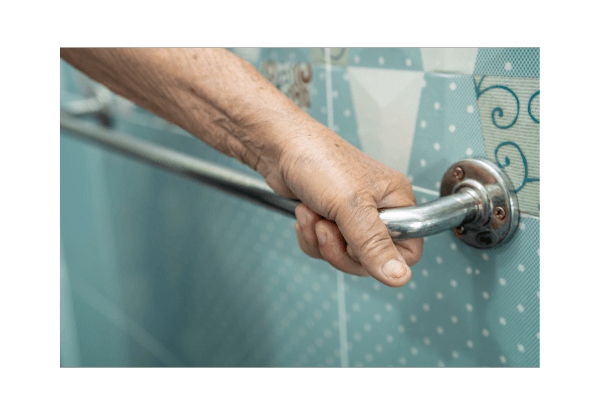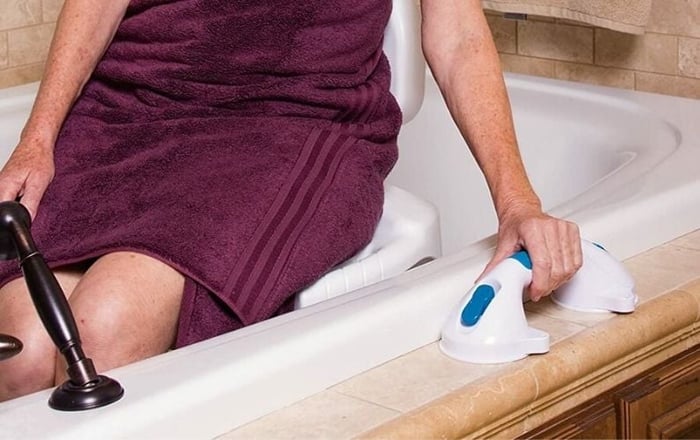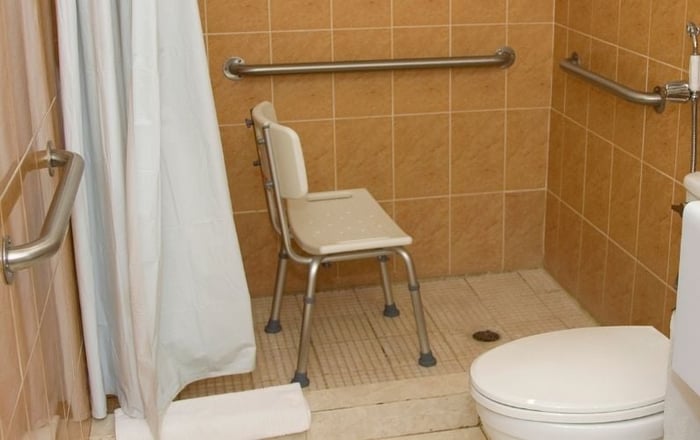Not surprisingly, the bathroom is the most dangerous room in the house. So, bathroom safety should be key to avoiding injury, particularly for seniors and caregivers. We wrote a blog about bathroom hazards two years ago, but given the importance of keeping our elders safe, we are again highlighting some key safety items for the bathroom.
In October 2020, the National Institute on Ageing reported that nearly 100% of Canadians over 65 prefer to age in their homes. This high percentage was undoubtedly driven even higher by the pandemic that started in March 2020 and its devastating effects on those in senior homes.
Two of the biggest reasons that persons have to go to assisted living are:
- They have had a bad fall (Read our Fall Prevention Tips)
- They can no longer take care of their grooming and hygiene.
As a start, always ensure that your bathroom is free of clutter, particularly the floor area; ensure towels are picked up, waste baskets are out of the traffic area, and mats are flat to the ground.
Given the high number of bathroom falls reported yearly, outfitting the home for bathroom safety is important. Here are the 12 top bathroom safety items to reduce the risk of falls.
1. Use Night Lights
Get multiple night lights. Many people wander to the washroom at night and will not turn on an overhead light, fearing it will interrupt their continued sleep. Gently light your way to the washroom rather than proceed in total darkness. Put a nightlight at a minimum in the hallway leading to the washroom and in the washroom itself. Nightlights can generally be purchased reasonably at a dollar store.
2. Put in Bath Mats
Ensure bath mats are used on the floor area. The greater the coverage area, the better, but most importantly, in the areas where moisture would normally or occasionally accumulate on the floor. The bath map chosen should be non-slip.
3. Use a Suction Bath Mat for tub
You can position a suction mat or use non-Slip textured strips for the bathtub or shower. These mats are designed to stick securely to the bottom of the bathtub or shower, providing a stable and slip-resistant surface.
4. Install Grab Bars
Install grab bars in any area where support is needed. Generally these can be placed beside the toilet, in the shower and just outside the shower. If a bathtub is used, bathtub rails can be installed.
Our team put together a list of the 6 Best Grab Bars.
5. Install a Raised Toilet Seat
Install a raised toilet seat. They seats generally range from 2 inches to 6 inches of elevation to a more comfortable level for the user. This makes it easier to sit down and get back up again.
For more support, a toilet safety frame can be installed. Toilet safety frames generally combine a raised toilet seat and side rails to assist for greater assistance.
6. Buy a Reach Wiper
Purchase a toilet aid for wiping or long reach wiper. These are designed to hold the toilet paper. Once the wiping is complete, press a button to release the toilet paper. There is no need to touch the toilet paper once it is soiled.
7. Get a Bath Chair or Bench
Bath stools or bath chairs have many safety benefits for the older adults. Swivel shower chairs have become increasingly popular if you have a spacious shower cubicle,
In cases of greater immobility, get a shower bench, rather than a shower chair. A bench is generally inside and outside the shower and bath. The user can sit on the bench and slide into the bathing area.
8. Install a Handheld Shower Sprayer
Install a handheld shower sprayer.
A handheld shower sprayer is invaluable for the elderly, offering them increased independence. With the flexibility to direct the water flow precisely where needed, seniors can maintain personal hygiene with minimal effort. This reduces the risk of slips or strains associated with traditional fixed showerheads.
This accessibility and control of a handheld shower sprayer can make daily bathing more manageable and comfortable, promoting confidence and preserving the dignity of elderly individuals as they age gracefully.
9. Install a Shower Caddy
Install a shower caddy into the shower cubicle. A shower caddy can either be attached to the wall, hang from the shower nozzle, or be on a pole inside the shower. These caddies keep toiletries such as shampoo, conditioner, soap, razors and shower mirrors.
10. Use a Weighted Shower Curtain
If you have a shower curtain, ensure that it is weighted for two reasons.
- Unweighted shower curtains can often blow into the shower due to a breeze from a window or fan; this can make unnecessary motion to push the curtain out.
- More importantly, a weighted shower curtain keeps the shower curtain inside the tub or shower enclosure, ensuring the water does not drop on the floor.
11. Use a Shower Brush or Sponge
Elderly individuals should consider using a long-handled shower brush or sponge for their safety during bathing, as it enables them to reach and cleanse their back, feet easily, and lower legs, reducing the risk of slips or falls. These tools offer added convenience and help maintain independence while promoting a more hygienic and safer bathing experience.
A long handled shower brush or sponge for back washing and hard to reach feet and lower legs
12. Use absorbent towels.
Consider a smooth floor, someone washing their face, showering or bathing, and a little water ends on that floor. Simple daily acts can create a slipping hazard.
It's very important that you completely dry off. All towels are not created equal. Polyester is not ideal for bathrooms; it needs to be absorbent. Egyptian or Turkish towels are absorbent and luxurious if money is no object. Bamboo towels are good for the environment and absorbent. The tried and true is 100% cotton towels. They are just as absorbent as the higher-end Egyptian or Turkish towels, yet less decadent, but they are a great choice.
Conclusion
The potential for bathroom accidents is significant, given the smooth floors, daily routines, and the necessity for frequent position changes. The bathroom is undeniably the most difficult room in our homes, particularly for seniors and their caregivers. Yet, because of modesty and privacy, many persons with mobility issues strongly resist assistance with bathroom care activities.
Simple measures such as reducing clutter, proper lighting, non-slip bath mats, and installing essential safety items like grab bars, raised toilet seats, and using shower chairs and other aids can significantly reduce bathroom-falls risk. By making homes safer and more conducive to maintaining independence, we can aid in maintaining dignity for ourselves and our loved ones as they age.
If you are interested in general safety in the home, read 7 Home Safety Tips you Should Know About and Aging in Place: How to Safely Prepare your Home for a Senior.










